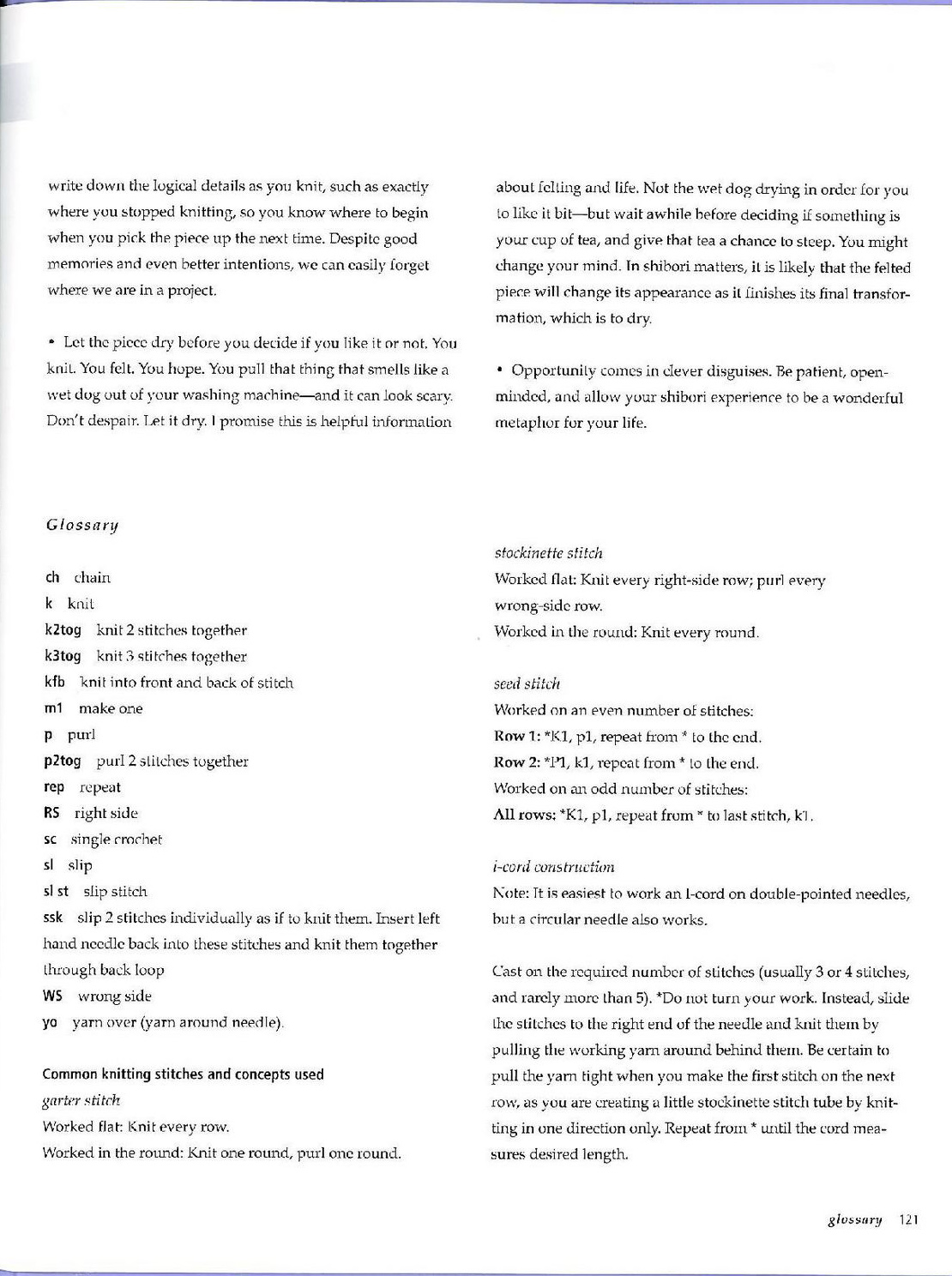S20C 409120813442

write down tłie logical details as you knit, such as exactiy where you stopped knitting, so you know where to begin when you pick the piece up the next time. Despitc good memories and oven better intentions, we can casily iorget where we are in a project.
• Lct the piece dry before you decide if vou like it or not. You knil. You fclt. You hope. You puli that thing that smells like a wet dog out of your washing machinę—and it can look scary. Don't despair. I>et it dry. I promise this is heiph.il infonnalion about fclling and life. Not the wet dog drying in order £or you to like it bit—but wait awhile hefore deciding if something is your cup of tea, and give that tea a chance to stcep. You might change your mind. In shibori matters, it is likely that the felted piece will change its appearance as it iinishes its finał transformat! on, which is to dry.
• Opportunily comes in clever disguises. Be pa Hen t, open-mindcd, and allow your shibori experience to be a wonderful metdplior for your life.
Głossary
ch cliain k knil
k2tog knit 2 stitches together k3tog knit 3 stitches togęther kfb knit into front and back of stitch m1 make one p purl
p2tog purl 2 stitches together rep repeat RS right side sc single rrochet sl slip
sl st slip stitch
ssk slip 2 stitches individualiy as if to knit them. Insert left hand nccdlc back inlo these stitches and knit them together Ihrough back Ioop W 5 wrong side
yo yarn over (yam around needle).
Common knitting stitches and concepts used
gar ter stitch
Worked fiat: Knitevery row.
Worked in the ronnd: Knit one round, purl one round.
sfockinette stitch
Worked Hat: Knit every right-side row; purl every wrong-sidc row.
Worked in the round: Knit every round. seed stitch
Worked on an even number ot stitches:
Row 1: *K1, pl, repeat from * to the cnd.
Row 2: *1*1, kl, repeat from * to the end.
Worked on an odd number of stitches:
Ali rows; *K1, pl, repeat from * to last stitch, k'l.
i-cord cons truciion
Notę: Tt is easiest to work an 1-eord on double-pointed needlcs, hut a circular needle aiso works.
Cast on the rcąuircd number of stitches (usually 3 or 4 stitches, and rarcly moro than 5). *Do not tum your work. Instead, slide Ihc stitches to the right end of the needle and knit them by pulling the working yam around behind them. Be cer tam to puli the yam tight when you make the first stitch on the next row, as you are creating a little stockinette stitch tubę by knitting in one direction only. Repeat from * until the cord mea-sures desired length.
głossary 121
Wyszukiwarka
Podobne podstrony:
S20C 409120813222 lail l m Part I! Work thc samo as Taił Fin Part I trem * to Next 4 raws Row 1 (R
S20C 409120813380 I contemplative wrap c on t i nued Bind off all stitches. Seciion W Work the same
S20C 409120813450 alchemy retailers Alchemv Yarns uf Ti ansformation can be found at these retailers
S20C 409120813380 I contemplative wrap c on t i nued Bind off all stitches. Seciion W Work the same
S20C 409120813231 Shibori Cred tivi ty expares the harmonious blending of felting and nonłelting fib
S20C 409120813380 I contemplative wrap c on t i nued Bind off all stitches. Seciion W Work the same
S20C 409120813432 Right Wing Using the Lop width cf thc .cft Winę as a guide, measure l le same dist
30088 S20C 409120813192 wood grain scarf Pnse.d on o classic Japanese łechnique knowti as mokume, th
kolibry w malwach (2) Next, add the details as descnbed, using the number of strands indicated by th
więcej podobnych podstron